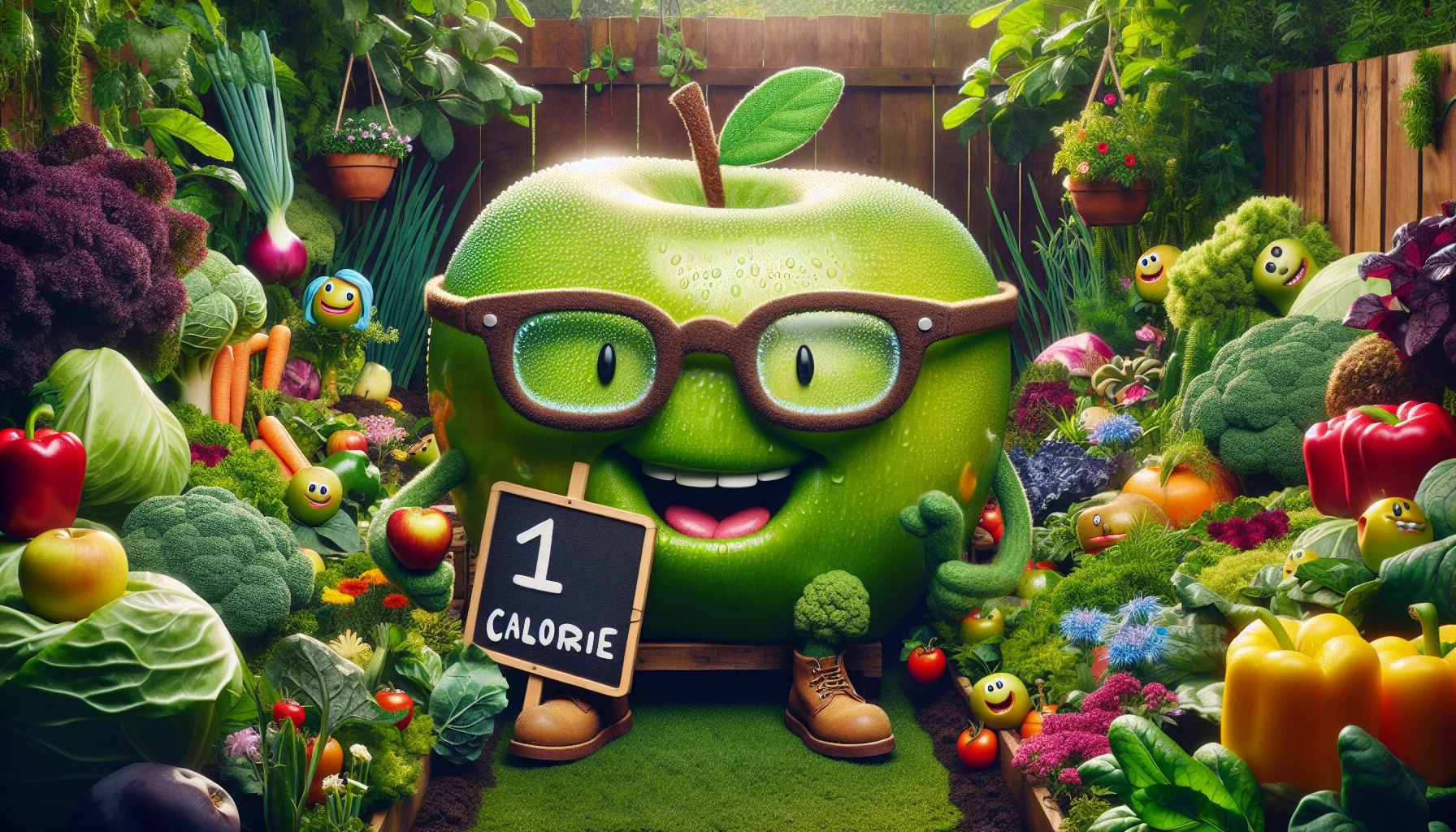1 green apple calories Quiz
Test Your Knowledge
Question of
The Nutritional Value of a Single Green Apple
A single medium-sized green apple, approximately 182 grams in weight, contains about 95 calories. This fruit is an excellent source of dietary fiber and vitamin C, contributing significantly to daily nutritional requirements. Its low calorie content, combined with a high fiber content, makes it an ideal snack for those looking to maintain a healthy weight or reduce their calorie intake. Including green apples in a balanced diet can aid in digestion, improve heart health, and provide the body with essential nutrients without adding excess calories.
Growing Green Apples in Your Garden
Planting and caring for green apple trees in your home garden can be a rewarding experience, offering fresh and delicious fruits right from your backyard. To start, you will need to select a suitable variety of green apple, such as Granny Smith or Golden Delicious, that is known to thrive in your climate zone.
Begin by choosing a planting location that receives full sunlight for at least six hours a day and has well-draining soil. It's crucial to test the soil's pH, aiming for a range between 6.0 and 7.0, to ensure the best growing conditions for your apple trees. Amend the soil as necessary before planting.
When planting your apple tree, dig a hole that is twice as wide and as deep as the root ball. Gently place the tree in the hole, making sure the graft union (the swollen area near the base of the trunk) is about 2 inches above the soil line. Fill the hole with soil, tamp down gently to remove air pockets, and water thoroughly.
After planting, it's important to water your apple tree regularly, especially during dry spells. A layer of mulch around the base can help retain soil moisture and regulate temperature. However, make sure the mulch is not touching the trunk to prevent rot.
Pruning is essential for the health and productivity of your apple tree. Prune in late winter while the tree is dormant, removing any dead, diseased, or overcrowding branches. This will encourage better air circulation and sunlight exposure, leading to a healthier tree and better fruit production.
Fertilizing your apple tree can also promote healthy growth. Use a balanced fertilizer in early spring before new growth begins, following the instructions on the label for application rates.
Finally, be on the lookout for pests and diseases common to apple trees, such as apple scab, codling moth, and apple maggot. Regular inspections and appropriate treatments can keep these issues at bay and ensure a bountiful harvest of green apples from your garden.
With patience and proper care, your green apple tree will start to bear fruit in a few years, providing you with a fresh and tasty reward for your gardening efforts.
The Journey of a Green Apple: From Seed to Snack
- Seed Planting
- Germination
- Sprouting
- Tree Growth
- Blossoming
- Pollination
- Fruit Development
- Fruit Ripening
- Harvesting
Comparing Green Apples to Other Fruits
| Fruit | Calories | Vitamin C | Fiber |
|---|---|---|---|
| Green Apple | 95 | 14% DV | 4.4g |
| Banana | 105 | 17% DV | 3.1g |
| Orange | 62 | 89% DV | 3.1g |
| Grapes (1 cup) | 104 | 27% DV | 1.4g |
Health Benefits of Green Apples
Green apples are not only delicious but they come packed with a variety of health benefits that can contribute significantly to a balanced diet. One of the most notable advantages of incorporating green apples into your daily diet is their high dietary fiber content. This essential nutrient plays a crucial role in digestive health, helping to regulate bowel movements and prevent constipation. Additionally, fiber has been known to aid in weight loss efforts by promoting a feeling of fullness, which can lead to reduced calorie intake.
Beyond fiber, green apples are a rich source of vitamins that are essential for maintaining overall health. They are particularly high in vitamin C, an antioxidant that supports the immune system, and vitamin A, which is important for vision and skin health. These vitamins, along with various other nutrients found in green apples, contribute to the fruit's ability to combat oxidative stress and reduce the risk of chronic diseases such as heart disease and diabetes.
Moreover, the consumption of green apples has been linked to improved heart health. The fiber content in these fruits can help lower cholesterol levels, reducing the risk of heart disease. Additionally, the polyphenols found in green apples, especially in the skin, have been shown to have a positive effect on blood pressure levels. Therefore, regularly including green apples in your diet can be a tasty and effective way to support cardiovascular health.
In conclusion, green apples are more than just a refreshing snack. They are a powerhouse of nutrients, offering a wide range of health benefits from digestive support to heart health and beyond. Incorporating green apples into your diet is a simple and delicious way to boost your intake of essential vitamins and minerals, contributing to a healthier lifestyle.
Creative Ways to Include Green Apples in Your Diet
- Green Apple and Walnut Salad - Toss sliced green apples with walnuts, mixed greens, and a light vinaigrette for a crunchy and refreshing salad.
- Apple Cinnamon Oatmeal - Start your morning with a warm bowl of oatmeal mixed with diced green apples, cinnamon, and a touch of honey for sweetness.
- Green Apple Smoothie - Blend green apples with spinach, banana, and almond milk for a nutritious and energizing green smoothie.
- Apple and Peanut Butter Snack - For a quick and healthy snack, slice green apples and serve with a side of peanut butter for dipping.
- Green Apple Salsa - Mix finely chopped green apples with onion, jalapeno, cilantro, and lime juice for a fresh salsa perfect for topping grilled chicken or fish.
- Apple, Brie, and Turkey Sandwich - Create a gourmet sandwich with sliced green apples, brie cheese, and turkey breast on whole grain bread.
- Green Apple and Beet Salad - Combine grated green apples and beets with a lemon dressing for a colorful and detoxifying salad.
- Apple Stuffed Chicken Breast - Stuff chicken breasts with a mixture of diced green apples, goat cheese, and herbs, then bake until golden and juicy.
- Baked Green Apple Chips - Thinly slice green apples, sprinkle with cinnamon, and bake until crisp for a healthy alternative to potato chips.
- Green Apple Curry - Add diced green apples to your favorite curry recipe for an unexpected burst of sweetness and texture.
The Environmental Impact of Growing Green Apples
Growing green apples, like all agricultural practices, has a significant impact on the environment. However, when managed sustainably, the cultivation of these popular fruits can contribute positively to the ecosystem. Sustainable practices in apple farming include integrated pest management (IPM), organic farming, and water conservation techniques. By employing these methods, growers can minimize their environmental footprint while producing healthy, delicious apples.
Integrated pest management is a crucial component of sustainable apple farming. IPM strategies aim to control pest populations using the least possible amount of chemicals, thereby reducing the pollution of soil and water sources. This approach often involves the use of natural predators, biopesticides, and crop rotation to keep pests at bay without harming the surrounding environment.
Organic farming practices further enhance the sustainability of growing green apples. By avoiding synthetic pesticides and fertilizers, organic apple orchards help maintain soil health and biodiversity. This not only benefits the environment by preventing chemical runoff but also supports pollinators and other beneficial organisms that play a vital role in the ecosystem.
Water conservation is another key aspect of sustainable apple farming. Efficient irrigation systems, such as drip irrigation, help to reduce water usage and prevent the wasteful runoff of water and nutrients. These systems deliver water directly to the roots of the plants, where it's most needed, thereby conserving this precious resource.
In conclusion, the environmental impact of growing green apples can be significantly mitigated through the adoption of sustainable farming practices. By focusing on integrated pest management, organic farming, and water conservation, growers can produce green apples in a way that is both environmentally responsible and economically viable. These practices not only protect the planet but also ensure the long-term sustainability of the apple farming industry.












